The fabric of Filipino culture is rich with various influences. But, how deeply do pre-colonial Philippines cats weave into this tapestry? Historical records hint that, along with well-known animals like pigs and water buffalo, cats sneaked into Philippine life. They probably came through early trade with Greeks, Romans, and Indians after 1000 A.D.1. These seafaring cats might have first landed in the islands hidden on ships or as needed rodent catchers. Over time, they became a cherished part of the colonial Philippines’ cat story.1
Key Takeaways
- Domestic cats became part of the Philippine cultural fabric alongside other domesticated animals such as pigs and chickens1.
- Their arrival in the Philippines was likely linked with trade interactions long before Spanish contact1.
- Felis domesticus played a unique role compared to livestock traditionally utilized in ritual and agriculture1.
- Cats may have sailed into Filipino hearts and homes through pre-colonial trade routes1.
- The emotional and historical connections between cats and Filipinos possibly date back to intricate global exchanges1.
The Introduction of Domestic Cats to the Philippines
The Philippines saw cats arrive as part of historic movements. These cats traveled wide during the time nations grew and traded more. This journey placed cats into the heart of ecosystems and cultures, including in the Philippines.
Trade Routes: The Catalyst for Cat Migration
Trading routes between Asia and the world were key to cats moving around. They didn’t just carry spices and textiles but also brought domestic cats across the Philippines and Southeast Asia. Because the Philippines was on these routes, cats became a big part of Filipino life. This followed a global trend of people and cats living together. It is believed that out of cats globally, 400 million are in Asia. This shows how important the region is in the story of domestic cats.
Historic Accounts of Cats on Spanish Galleons
The Spanish could have brought cats to the Philippines on their ships. Cats likely helped by catching rats on these ships. This helped keep the ship’s food safe and started the friendship between people and cats at sea. A story from Antonio Pigafetta, who sailed with Magellan in the 16th century, talks about seeing cats in the Visayas. This shows cats have been part of the Philippines’ history for a long time.
Many of the world’s cats live in Asia, making it key to understand the old connections of trade, sea journeys, and cat domestication in places like the Philippines.
Domestic cats traveled with humans for thousands of years from their start in the Fertile Crescent. They were believed to have been first domesticated around 12,000 years ago. From there, they moved to trading ships and into the Philippines. This shows the Philippines’ role in the greater story of cats around the world.
- The arrival of domestic cats in the Philippines correlates with the spread of Felis catus along ancient trade routes.
- Cats served an essential role as mousers on Spanish galleons, introducing them to island destinations, including the Philippines.
- Historic accounts, like those of Antonio Pigafetta, annotate instances of Philippines cat introduction, hinting at the cultural significance of these animals throughout time.
The bringing of domestic cats to the Philippines is a part of bigger cat movements. These movements show how trading paths helped cats become part of Filipino life.
Felis Domesticus: Understanding the Domestic Cat
The story of the domestic cat or Felis domesticus, is deeply entwined with human history. These cats have become more than pets; they’ve grown to share a deep bond with humans worldwide.

Today, there are over 600 million cats living with people all over the planet. In some places like Japan, there are more cats than dogs. Here, cats number at 9,526,000, compared to 8,920,000 dogs2. This large number highlights Felis domesticus roles not just as friends but as key members of our ecosystem.
Evolving Roles of Cats Through History
Cats started their journey with humans about 9,500 years ago2. They went from hunters of pests to loved family pets. This change shows how cats and people have worked together over time.
Domestication and Adaptation in Southeast Asia
Cats in Asia are a great example of this bond. According to research, cats have become really good at communicating with humans2. They can recognize their names and even understand some words we say to them2.
Dogs might be better at understanding more human words than cats. Still, cats have shown they can learn words that are important to them, like their names2.
To wrap it up, the journey and roles of domestic cats, especially their adaptation in Southeast Asia, show a fascinating part of our history together. It proves the strong bond between humans and Felis domesticus.
Sociocultural Perceptions of Cats Pre-Spanish Arrival
The importance of cats in the Philippines before the Spanish arrived is pretty interesting. Historical stories tell us that cats and people had a dynamic relationship. Cats played many roles, from controlling pests to being part of local legends. This shows how varied Filipino societies were even before the Spanish came.
Cats have been part of Southeast Asia’s natural world for a long time. This suggests a deep bond between people and cats that goes beyond just living together. Cats being both predators and pets shows the complexity of this relationship. While they pose a threat to some wildlife, many have also become beloved pets.
In cities, the line between natural and man-made gets fuzzy when it comes to cats. Feral cats and pets living freely are seen as part of our environment. However, their presence brings up many social and ethical issues.3 Controlling cat populations in urban areas leads to debates that mix freedom, science, cultural views, and ethics.
The welfare of city cats is a big topic. It focuses on how they feel, live, and their health. But helping individual cats might not always be what’s best for all cats. This makes the role of veterinarians and animal welfare efforts complex and wide-ranging.
Studies from countries like Great Britain and the United States offer valuable lessons on managing city cats. They show how differently people interact with cats and how it affects local views and policies.
https://www.youtube.com/watch?v=1SySUOBnQfI
Cats: From Stowaways to Symbols of Domesticity
The story of cats in the Philippines is truly fascinating. They started as cats as stowaways on ships, showing how they journeyed through history. Now, they’re seen as loveable symbols of home life. The
The role of cats in Filipino culture has evolved beautifully. It’s more than just surviving a journey from the ship to home. It’s about how they’ve been welcomed into society. The domestic cats maritime history tells a story of independence and how cats have become part of our shared story, with a legacy that touches both the seas and our homes.
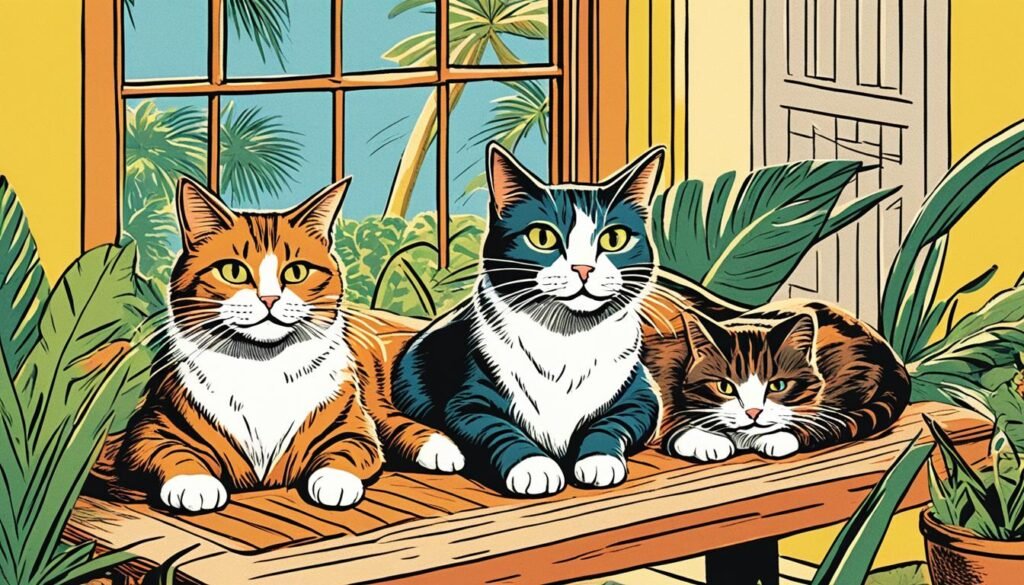
Cats as Companions on Long Voyages
Cats have a unique maritime history, joining humans on many sea adventures. They were valued for keeping ships free of pests. This job was essential for protecting food on long voyages. Their time at sea also spread them around the world, bringing them to places like the Philippines.
Integration of Cats into Filipino Households
The connection between people and cats has grown strong over time. When these maritime cats arrived in the Philippines, they fitted right into families. They adjusted well to living on land, becoming beloved by many households. This shows how cats went from being just handy stowaways to becoming important family members.
The Role of Cats in Filipino Mythology and Religion
In Filipino mythology, cats have a special place in the nation’s spiritual history. Each ethnic group has its own gods, making the mythology very rich with over a hundred pantheons4. In the Ifugao group alone, there are more than 1,500 gods4. Cats are very important in these beliefs. They are often seen as sacred and are called “anito”4.
Pre-Colonial Spiritual Significance of Cats
Long ago, Filipinos deeply respected nature and its spirits, including cats. Cats were seen by some groups as bridges between our world and the spirit realm. They symbolized sacred or mystical qualities.
Transition of Beliefs in Colonial Times
When the Spanish came in the late 14th century with Christianity, the Filipino religious world changed4. But the old ways and the respect for cats lived on in secret. Efforts to bring back these old beliefs show how important cats have always been4. There are over 370 mythological beings like the Agta and the Akop, showing cats’ role in folklore5.
| Creature | Description | Culture |
|---|---|---|
| Abak | Malevolent spirit | General |
| Abat | Aswang-like creature | Waray/Tingguian |
| Ada | Fairy-like being | General |
| Agalon Hayopan | Folkloric entity | Bicol |
| Aghoy | Mystical being | Waray |
| Agta | Dark being residing in mangroves/swamps | General |
| Akop | Evil entity with elongated limbs | Tingguian |
| Alan | Being with distinct physical features, varies per tale | Tingguian |
The many myths of the Philippines show its unique role as a center of myth and religion5. As Filipinos learn more about their heritage, mythological cats remind them of their past and evolving identity.
Comparative Analysis: Cats Versus Other Domesticated Animals
In the Philippines, cats versus domestic animals offer insight into animal domestication and cultural perceptions. While dogs and livestock have clear roles in society, cats fit more subtly into the socio-economic landscape, highlighted in a Philippines domestication comparison. Studies show cats and dogs have differing decision-making skills, pointing to unique cognitive traits6.
Research in labs shows cats choose less often than dogs, suggesting they are more independent or think differently. This contrasts how dogs have been historically viewed, relying on human cues6. Dogs usually pass tests on responding to human signs, showing their roles beside humans6.
Dogs have evolved to follow human directions closely, aiding in hunting, guarding, and companionship6. In contrast, 41.4–60.9% of cats finish similar tests, which shows they evolved differently regarding human interaction6. This affects cats’ roles in Filipino society, where, unlike pigs important in rituals, cats play less visible roles.
Cats in the Philippines have a unique place, different yet similar to other domestic animals, more about home life than ceremonial roles6.
| Animal Type | Ceremonial Use | Utilitarian Role | Response to Human Cues |
|---|---|---|---|
| Cats | Less pronounced | Companions, Vermin control | 41.4–60.9% complete tests6 |
| Dogs | Variable | Hunting, Guarding, Companionship | No reported dropout rate6 |
| Pigs | High | Economic marker | N/A |
Older cats are better at making choices than younger ones, suggesting they learn and adapt as they age6. This reflects the long history of cats living with humans in the Philippines, adapting over time.
Comparing cats to other domestic animals sheds light on their varied roles in society. It reveals different behaviors and cognitive skills among pets, telling a story of domestication and living together, especially in the Philippines.
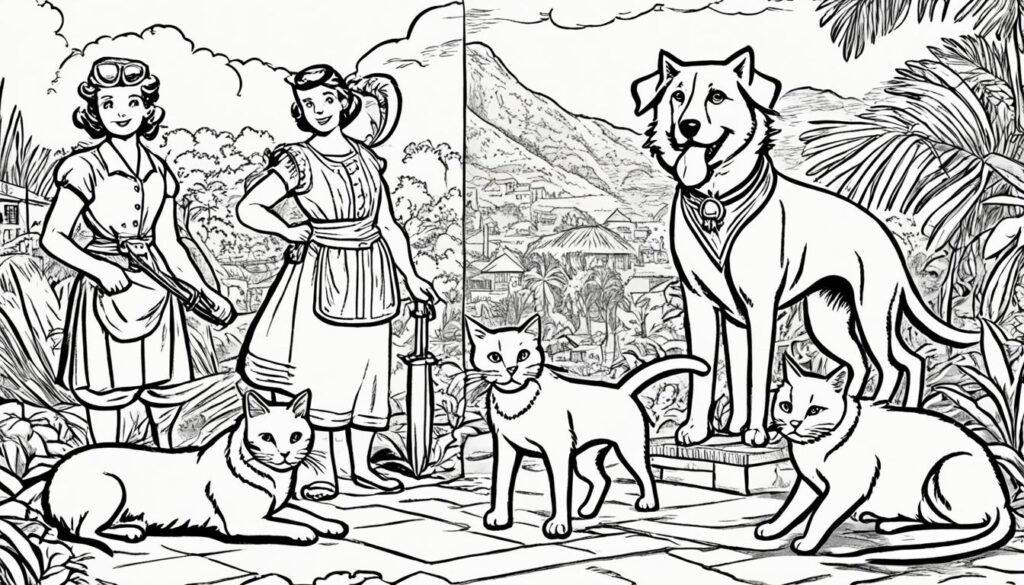
Impact of Cats on the Local Ecosystem and Economy
Cats have a complex effect on the ecosystems in the Philippines. They provide benefits but also bring challenges to the local ecology. Their economic impact is also significant but needs more study.
Ecosystem Roles: Cats as Pests and Protectors
Some conservationists see domestic cats as a threat to biodiversity. They often cause the numbers of certain wild animals to drop7. Yet, cats also help control rodent populations and can protect some endangered birds7. In different places, from cities to deserts, how cats interact with the natural world shows their complicated role7.
Feral cats are tough to manage. Apex predators, like coyotes in the US and dingoes in Australia, help keep their numbers in check7. This balance is vital for native wildlife and shows why we must protect these larger predators.
Trade and Economic Contributions of Cats
While it may not seem obvious, cats affect both local and global economies. For example, they influence fish stocks worldwide because of the demand for pet food8. However, efforts to control cat populations through spaying, neutering, and Trap-Neuter-Return (TNR) can reduce their negative impact8.
Cats, both pet and stray, contribute to high wildlife mortality, especially in the US. This situation could mirror what happens elsewhere, including the Philippines. The size of the feral cat population deeply affects bird and mammal deaths9. Managing these cat populations is crucial for ecological and economic balance.
| Ecosystem Impact | Economic Contributions |
|---|---|
| Predation on wildlife, potentially threatening biodiversity7 | Influence on global fisheries due to pet food production demands8 |
| Maintenance of rodent populations, assisting in conservation7 | Management programs affecting municipal budgets and public health8 |
Cats play dual roles in our world – they can be both problematic and beneficial. Tackling the cat issue in the Philippines needs careful thought, blending ecological and economic considerations.
The Presence of Feral Cat Colonies in Colonial Philippines
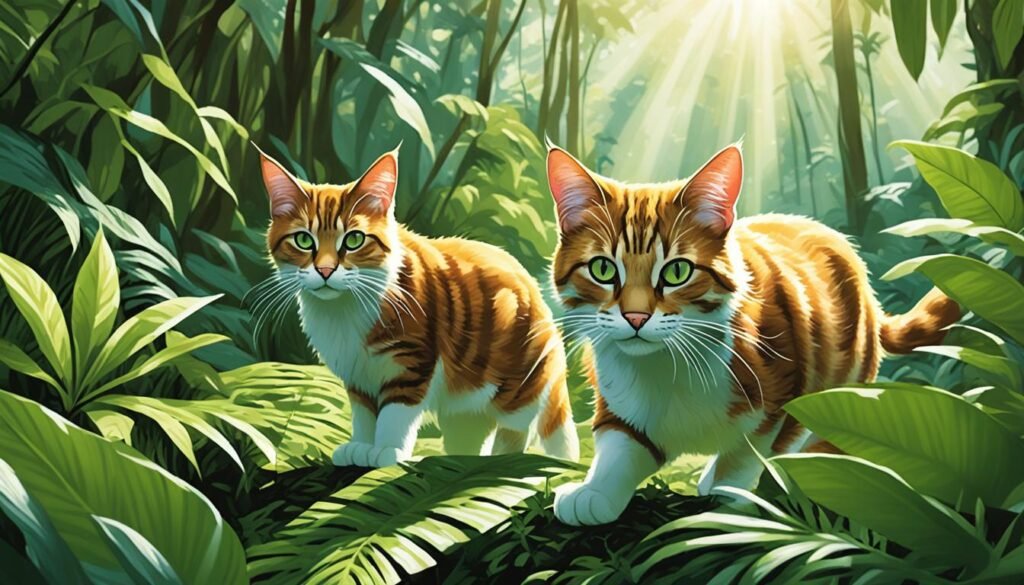
The story of feral cats in colonial Philippines is quite a mystery. A look at the history of feral cat colonies shows it’s hard to detail due to few old records. Still, it’s clear that feral cats were around during those times. They show the cats’ strong will and how they lived without needing people.
These cats were very independent and knew how to survive. This led to them forming groups. Cats were initially brought on ships for company and to catch mice. Some of these cats may have escaped or were abandoned, creating wild groups. These groups lived near human places, often helping each other out.
Even though there’s not much written down, stories tell us these wild cats helped control pests back then.
People back in colonial times had mixed feelings about these wild cats. Some saw them as helpful in getting rid of pests, while others didn’t like them. Yet, the fact that their descendants are still around today shows they’ve been a part of the Philippines since those early days.
Feline Depictions in Philippine Art and Literature
Cats in Philippine culture are more than just animals. They symbolize many things in art and literature. Cats in Philippine art are rare but they show how cats and culture mix.
Artistic Representations of Cats in Pre-Colonial Culture
Pre-colonial cat depictions are fascinating but not common. They make us wonder what cats meant to early Filipinos.
Literary Reflections: Cats in Colonial Narratives
When the colonizers came, so did new stories about cats. In these tales, cats softly tread, capturing the time’s spirit.
In Gemma Cruz Araneta’s home, history and art meet cats cats reign home Gemma Cruz Araneta10. Her love for cats is clear in her living space, surrounded by art and history books. Araneta has a deep interest in Philippine history, showing in her collection on Magellan and Lapulapu10.
| Gemma Cruz Araneta’s Love for Cats and History | |
|---|---|
| Feline Companions | Milonga, Jarocho, and Merengue10 |
| Cultural Interests | Preparation for quincentennial celebrations10 |
| Artistic Displays | Works of Benjamin Mendoza in residence10 |
| Architectural Preferences | Designs by Dom Galicia, blending heritage and modernity10 |
Cats
The historical arrival of cats in the Philippine archipelago tells more than just a tale of travel and trade. It’s part of the bigger story of human growth and civilization. Cat domestication started in the Fertile Crescent. This partnership between humans and cats grew in ancient Egypt11.
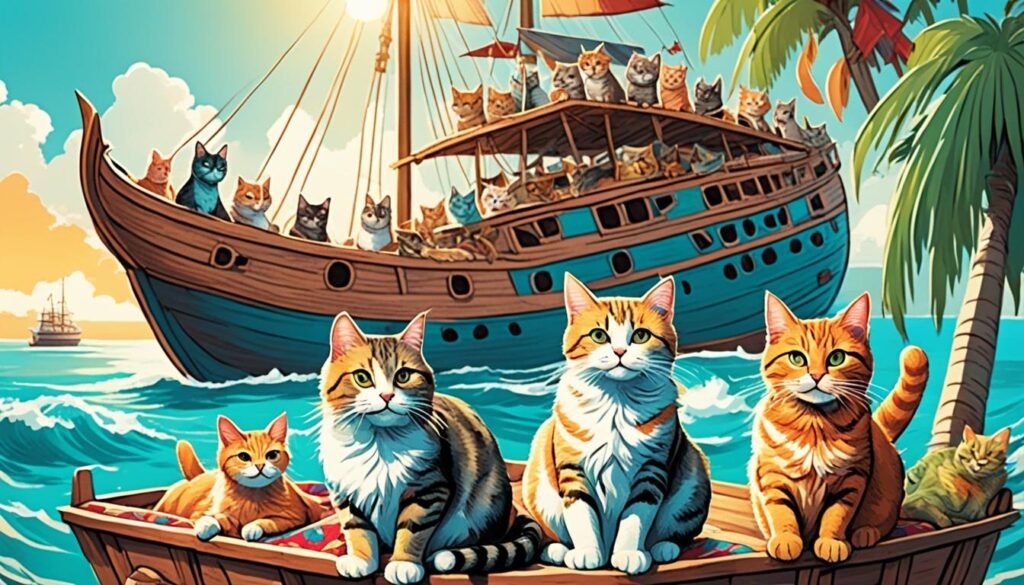
The Arrival of Cats in the Philippines: A Historical Perspective
Ancient DNA analysis shows cats traveled the world on ships. They controlled rodent populations. Their arrival in the Philippines majorly impacted the cat’s role in Philippines culture and society11.
Cats as an Integral Part of Filipino Folklore
In the rich fabric of Filipino folklore cats emerge as beings with diverse roles. Though not widely recorded, these stories show cats’ various interactions with Filipino life. They were seen as protectors and symbols of mystery and luck, showing their cultural value.
Selective breeding for traits like coat color in tabby cats began in the medieval period. This was long after they were domesticated11. Even patterns of aggression varied among different coats, like tortoiseshell and calico. This indicates a rich cultural interaction with these animals11.
Today, cats’ legacy in the Philippines lives on as they fill cities and countrysides. They remind us of their historical significance while becoming part of modern Filipino homes.
Spanish Colonial Records and Their Influence on Cat Populations
The history of Spanish colonial Philippines is fascinating. Especially when it comes to domestic animals like cats. Through colonial records cats have shown to be key in the region’s ecosystems, affecting biodiversity and local traditions. These records help us see how cats shaped communities and the environment.
Research provides a detailed look at cats in that era. For instance, studies of their scat show 81.6% contained rabbits12. This shows their role as natural population controllers. Also, during food shortages, 21.5% of their diet was carrion12, showing their ability to adapt.
Spanish records highlight differences in how male and female cats lived. With females having a home range of 151 hectares and males 284 hectares12. This suggests their territorial behavior affected the era’s ecological and agricultural patterns.
Dietary breadth and dietary overlap rose when rabbits, a primary prey, were scarce12. A 75% overlap in diet between cats and foxes, despite some food sharing, likely changed how they competed12. Cats were crucial in this interdependent ecosystem.
Looking at colonial records shows how cats adapted to environmental changes. When rabbits were fewer, cats ate more carrion12. Even with fox predation on cats, their numbers didn’t rise after foxes were removed12. This points to ongoing competition between cats and foxes.
Cats had a significant impact on the region’s nature and society during the colonial period. They went from pets to important ecological parts. Spanish records offer a deep insight into cats’ roles in Philippine society back then.
Surviving Records of Cats in Archipelago-inspired Mythos
The Philippine archipelago is filled with myths and folklore, featuring cats in key roles. These stories show the special place cats hold in local culture. This gives us a peek into how important cats have been throughout history. Studies of these myths highlight cats’ roles beyond just being pets or pests.
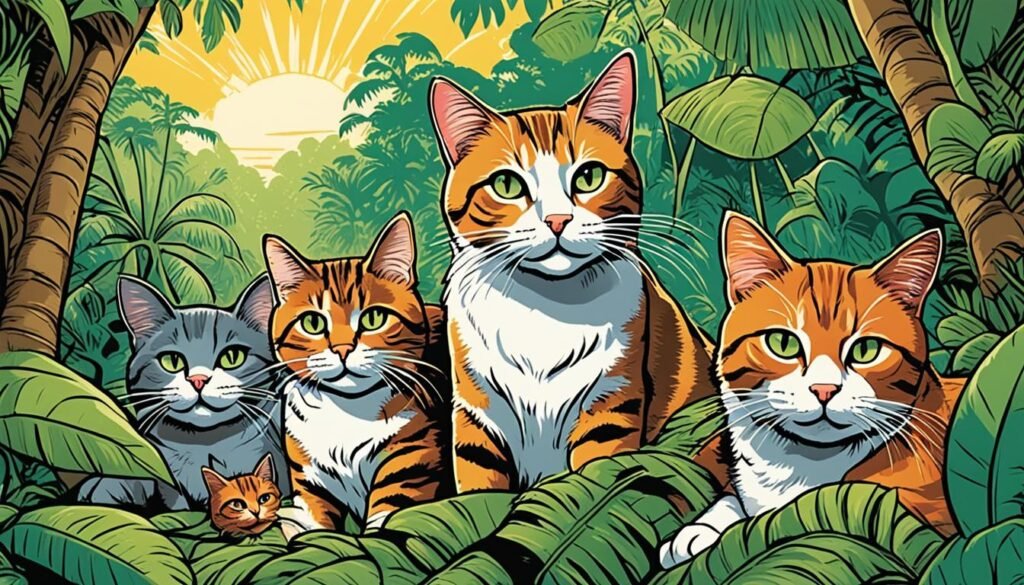
When we look at historical records, we see how cats were seen in Philippine life. It’s hard to find detailed studies about cats in these records. But, the bits we do find make it clear we should rethink how we view Philippine cats. We learn about the symbolic meanings of cats in local stories.
Allegorical Uses of Cats in Myths and Legends
Old beliefs shine through in the tales handed down over time. Cats in myths display cleverness and smarts, showing what early Filipinos valued. Cats often stood for deeper messages in these stories. They connect spiritual beliefs with the real world. These tales let us peek into how ancient peoples viewed their world.
Primary Sources and Anthropological Studies
Researchers have looked through many sources to find out about cats in Filipino culture. They’ve studied everything from Spanish records to stories told in villages today. While detailed studies on Philippine cats are rare, exploring relics and local practices sheds light on how they fit into society. This helps show the lasting influence cats have had in various parts of life in the islands.
While some ancient texts and stories have survived, specifics about cats in Philippines’ myths are hard to find. Still, the stories we have suggest cats have affected local life and nature13. Studies are key to understanding these roles and bringing the stories of cats back into the nation’s cultural picture.
Conclusion
Cats have a unique story in the Philippine feline history. This story is more than just how cats became pets. It shows how different cultures mix and adapt. Cats started as travelers on ships and now are loved family members in the Philippines. This journey shows how Filipino culture includes many influences. Cats fit perfectly into both city and rural life. This shows their adaptability and how close humans and animals can become.
Trade played a big part in bringing cats around the world. Cats used to travel with goods and people across seas. By looking at this, we see how connected different places are. The use of animals in research has changed a lot too. Before, many animals from certain dealers were used in studies. But now, much fewer animals are used. This change shows we care more about how we treat animals. It reflects how both the Philippines and the world view animals now.
Now, cats are a big part of life in the Philippines. It’s important to see how our thoughts on animals have shifted. There are programs working to make sure animals and humans can help each other. For instance, some dogs are specially raised for research. These efforts spark important discussions on how we use animals in science14.
FAQ
What is the scientific name of domestic cats, and when were they first present in the Philippines?
The scientific name for domestic cats is Felis domesticus. They arrived in the Philippines by the 16th century, during the Spanish contact era.
How did domestic cats make their way to the Philippines?
Cats likely came to the Philippines through ancient trade routes. This happened after 1000 A.D., connecting Greece, Rome, India, and Southeast Asia. They were onboard ships for their abilities to control pests and for company.
Are there any historic accounts mentioning cats in the Philippines during the Spanish colonial period?
Yes, Antonio Pigafetta from Magellan’s crew saw cats in the Visayas. This shows cats were part of life in some Philippine regions during the early Spanish times.
How did the domestication of cats occur in Southeast Asia?
In Southeast Asia, cats were selectively bred for traits that made them good companions for humans. This breeding helped cats live in various environments, including on ships. This spread them across the region.
What were the sociocultural perceptions of cats in the Philippines before the arrival of the Spanish?
Before the Spanish came, cats in the Philippines likely had practical and cultural roles. The specifics aren’t well-documented, but they were part of local economies and practices.
How did the role of cats evolve after arriving in the Philippines?
Cats went from being valued for pest control on ships to symbols of home life. They became domestic companions, showing a change in their role.
What is known about the role of cats in pre-colonial Filipino spirituality and religion?
Cats probably had symbolic significance in indigenous spiritual practices. However, the details are not well-recorded. Their role might have evolved with Spanish colonial religious influences.
Did cats have an impact on local ecosystems and economies in the Philippines?
Yes, cats had a complex impact. They controlled pests but also threatened other species. Their exact effect on the economy and ecology is not fully documented.
Were there feral cat colonies in colonial Philippines?
Feral cat colonies show cats could live without human support. While detailed accounts are rare, their presence indicates they adapted well.
How are cats depicted in Philippine art and colonial literature?
Cats are not often seen in colonial Philippine art and literature. Yet, things like the Boxer Codex offer a glimpse into how pre-colonial and colonial societies viewed cats.
What cultural significance do cats have in Filipino folklore?
Cats play roles in Filipino folklore, showing their interactions with humans and adaptation to environments. But these roles are not extensively documented.
What do Spanish colonial records tell us about cats in the Philippines?
Spanish colonial records show how cats integrated into daily life and societies. In regions like the Visayas, they were a visible part of life.
Are there allegorical uses of cats in Philippine myths and legends?
Cats may be used allegorically in Philippine myths and legends. But, due to scarce primary sources, their full meanings are still unclear without more study.
Source Links
- https://en.wikipedia.org/wiki/Animal_domestication_and_management_in_the_Philippines
- https://www.nature.com/articles/s41598-019-40616-4
- https://www.ncbi.nlm.nih.gov/pmc/articles/PMC8000346/
- https://en.wikipedia.org/wiki/List_of_Philippine_mythological_figures
- https://www.aswangproject.com/creatures-mythical-beings-philippine-folklore-mythology/
- https://www.nature.com/articles/s41598-023-45008-3
- https://phys.org/news/2020-07-dont-blame-cats-wildlife-shaky.html
- https://www.wellbeingintlstudiesrepository.org/cgi/viewcontent.cgi?article=1000&context=aw_comp_globalcats_managementgen
- https://www.nature.com/articles/ncomms2380
- https://www.philstar.com/lifestyle/modern-living/2019/03/23/1903700/art-history-books-and-cats-reign-home-gemma-cruz-araneta
- https://www.loc.gov/item/how-did-cats-become-domesticated/
- https://core.ac.uk/download/pdf/41229576.pdf
- https://www.atlasobscura.com/articles/iceland-cat-ban-law
- https://www.ncbi.nlm.nih.gov/books/NBK32673/

